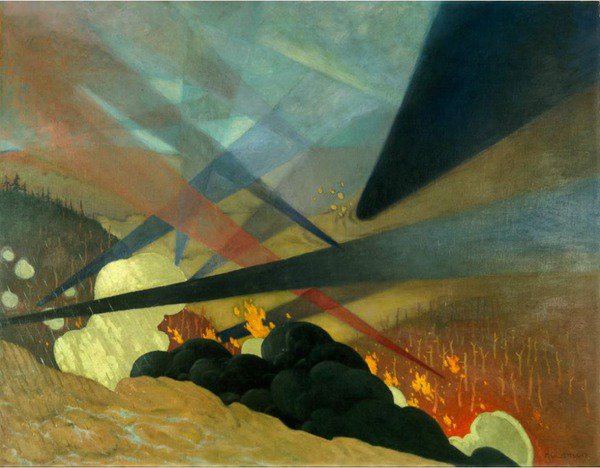1917
dal 25/5/2012 al 23/9/2012
Segnalato da
25/5/2012
1917
Centre Pompidou - Metz , Metz
This exhibition addresses the theme of artistic creation in wartime. Originating with Picasso's creation of his largest work, the stage curtain for the ballet Parade, in 1917, the show examines artistic production of that crucial year in light of historical facts and their impacts on the lives of the artists.

Curators:
Claire Garnier, Curator, Centre Pompidou-Metz
Laurent Le Bon, Curator, Director of the Centre Pompidou-Metz
1917 stands out for the extreme diversity of its artistic production. The exhibition sets out to convey this diversity by mapping the various positions of the artists relative to the battlefront. Taking their place alongside the masters are the amateur artists who felt the need to respond to the trials of war through creative expression such as trench art.
As one of the highlights, 1917 presents, in an exceptional staging, Picasso's largest work: the stage curtain for the ballet Parade, last shown in 2004 in Hong Kong and its first showing in France in over twenty years.
The exhibition examines artistic production of that crucial year in light of historical facts and their impacts on the lives of the artists.
1917 offers an instant view of every field of creativity during this year of the First World War. It asks what such a narrow, precise context as a single year might mean for creative activity, while avoiding the pitfalls of expectations and assumptions as to the nature of wartime art. By focusing on one year in the 20th century, 1917 also explores a rarely attempted, original exhibition format.
1917 testifies to the extreme diversity of its artistic production. Presented on over 2300 square meters and in two sections, the exhibition conveys this diversity by mapping the various positions of the artists relative to the battlefront, and subsequently their degree of physical, psychological, symbolical or intellectual involvement in the issues of war.
Alongside masters such as Brancusi, Dix, Duchamp, Kandinsky, Matisse, Monet, or Nevinson, were amateur artists who felt the need to respond to the trials of war through creative expression such as Trench art, examples of which are a high point of the exhibition. Equally important are the war artists who were sent to the front to record its events, and the many individuals who, as eyewitnesses, expressed their memory of the conflict for posterity.
From physical and psychological destruction and rebuilding through self-portraiture, to the confusion between gender, and the transformation associated with camouflage, two major figures arise: the Harlequin and the stage curtain for the ballet Parade, whose monumental format and remarkable presentation constitute the climax of the exhibition. This masterpiece by Picasso was last shown in 2004 in Hong Kong and is shown in France for the first time in over twenty years.
The exhibition gathers works from public, private, art, and military collections, both French and international. Foremost among these are the many works drawn from the collection of the Centre Pompidou, Musée national d'art moderne. 1917 also benefits from partnerships with the Bibliothèque de Documentation Internationale Contemporaine (Nanterre), the Établissement de communication et de production audiovisuelle de la défense (Ivry-sur-Seine), the musée de l'Armée (Paris), the musée du Service de Santé des Armées (Paris), the Historial de la Grande Guerre (Péronne) and the Imperial War Museums (London).
1917 is endorsed by the Ministry of Defence and Ex-Servicemen. The exhibition is the first in a series of cultural events about the Great War leading up to international commemorations of the centennial of the First World War.
A 600 page catalogue will be published to coincide with the opening of the exhibition, followed by a symposium in September 2012.
A programme of films, lectures and performances will run alongside the exhibition, such as a cine-concert by Jeff Mills scheduled for 26 May 2012.
-----
In 2013, the Centre Pompidou-Metz is organizing a second exhibition dedicated to LeWitt, this time featuring an unprecedented ensemble culled from his personal collection including over 250 artworks and documents by LeWitt and numerous other artists. Centre Pompidou-Metz' two-fold project will thus reflect LeWitt's extraordinary career not only as a prolific artist but also as an insatiable collector.
Image: Félix Édouard Vallotton, Verdun, Tableau de guerre interprêté [sic] projections colorées noires bleues et rouges terrains dévastés, nuées de gaz, 1917
Huile sur toile, 114 x 146 cm Paris, Musée de l’Armée © Paris - Musée de l'Armée, Dist. RMN / Pascal Segrette
Communications and Press Relations Officer Centre Pompidou-Metz
Louise Moreau presse@centrepompidou-metz.fr
National and international press
Claudine Colin Communication - Valentine Dolla Tel: 0033 (1) 42726001 centrepompidoumetz@claudinecolin.com
Centre Pompidou-Metz
1, parvis des Droits-de-l'Homme CS 90490 57020 Metz Cedex 1, France
Hours:
Monday 11 a.m. - 6 p.m.
Tuesday closed
Wednesday - Friday 11 a.m. - 6 p.m.
Saturday 10 a.m. - 8 p.m.
Sunday 10 a.m. - 6 p.m.
Last ticket sales 45 minutes before closing time.
open every day, including public holidays. It is closed on Tuesdays and May 1st.
Starting 1 May 2012, the Centre will close at 6pm on Thursdays and Fridays.
One single price: 7€
Free admission for the under 26s



